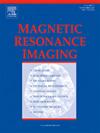Subject-specific acceleration of simultaneous quantification of blood flow and T1 of the brain using a dual-flip-angle phase-contrast stack-of-stars sequence
IF 2
4区 医学
Q2 RADIOLOGY, NUCLEAR MEDICINE & MEDICAL IMAGING
引用次数: 0
Abstract
Purpose
To develop a highly accelerated MRI technique for simultaneous quantification of blood flow and T1 of the brain tissue.
Methods
A dual-flip-angle phase-contrast stack-of-stars (DFA PC-SOS) sequence was developed for simultaneous acquisition of highly-undersampled data for the quantification of velocity of arterial blood and T1 mapping of brain tissue. A deep learning-based algorithm, combining hybrid-feature hash encoding implicit neural representation with explicit sparse prior knowledge (INRESP), was used for image reconstruction. Magnitude and phase images were used for T1 mapping and velocity measurements, respectively. The accuracy of the measurements was assessed in a quantitative phantom and six healthy volunteers.
Results
T1 mapping obtained with DFA PC-SOS showed high correlation and consistency with reference measurements in phantom experiments (y = 0.916x + 4.71, R2 = 0.9953, ICC = 0.9963). Blood flow measurements in healthy volunteers demonstrated strong correlation and consistency with reference values measured by SFA PC-SOS (y = 1.04x - 0.187, R2 = 0.9918, ICC = 0.9967). The proposed technique enabled an acceleration of 16× with high correlation and consistency with fully sampled data in volunteers (T1: y = 1.06x + 1.44, R2 = 0.9815, ICC = 0.9818; flow: y = 1.01x - 0.0525, R2 = 0.9995, ICC = 0.9998).
Conclusion
This study demonstrates the feasibility of 16-fold accelerated simultaneous acquisition for flow quantification and T1 mapping in the brain. The proposed technique provides a rapid and comprehensive assessment of cerebrovascular diseases with both vascular hemodynamics and surrounding brain tissue characteristics, and has potential to be used in routine clinical applications.
使用双翻转角相衬星图序列同时量化血流和大脑T1的受试者特异性加速。
目的:开发一种同时量化脑组织血流和T1的高加速MRI技术。方法:开发了双翻转角相对比叠星(DFA PC-SOS)序列,用于同时获取高度欠采样数据,用于量化动脉血流速度和脑组织T1制图。将混合特征哈希编码隐式神经表示与显式稀疏先验知识(INRESP)相结合的深度学习算法用于图像重建。震级和相位图像分别用于T1映射和速度测量。测量的准确性在定量幻影和6名健康志愿者中进行了评估。结果:DFA PC-SOS得到的T1映射与幻影实验的参考测量值具有较高的相关性和一致性(y = 0.916× + 4.71,R2 = 0.9953,ICC = 0.9963)。健康志愿者的血流量测量值与SFA PC-SOS测量的参考值具有很强的相关性和一致性(y = 1.04×-0.187, R2 = 0.9918,ICC = 0.9967)。所提出的技术使16倍的加速度与志愿者的全采样数据具有高度的相关性和一致性(T1: y = 1.06× + 1.44,R2 = 0.9815,ICC = 0.9818;流:y = 1.01×-0.0525,R2 = 0.9995,ICC = 0.9998)。结论:本研究证明了16倍加速同步采集用于脑流量定量和T1定位的可行性。该技术提供了一个快速和全面的评估脑血管疾病的血管血流动力学和周围脑组织的特征,并有潜力在常规临床应用。
本文章由计算机程序翻译,如有差异,请以英文原文为准。
求助全文
约1分钟内获得全文
求助全文
来源期刊

Magnetic resonance imaging
医学-核医学
CiteScore
4.70
自引率
4.00%
发文量
194
审稿时长
83 days
期刊介绍:
Magnetic Resonance Imaging (MRI) is the first international multidisciplinary journal encompassing physical, life, and clinical science investigations as they relate to the development and use of magnetic resonance imaging. MRI is dedicated to both basic research, technological innovation and applications, providing a single forum for communication among radiologists, physicists, chemists, biochemists, biologists, engineers, internists, pathologists, physiologists, computer scientists, and mathematicians.
 求助内容:
求助内容: 应助结果提醒方式:
应助结果提醒方式:


